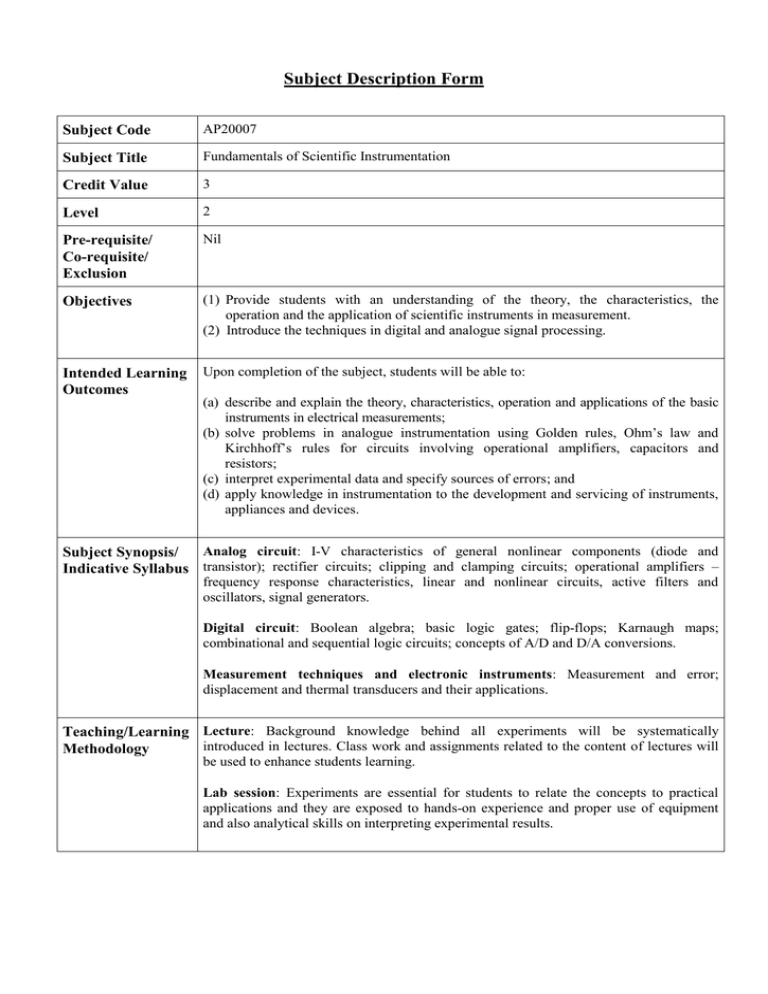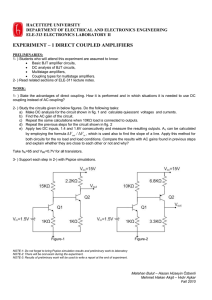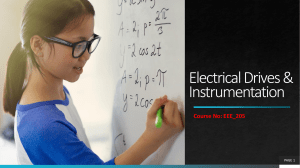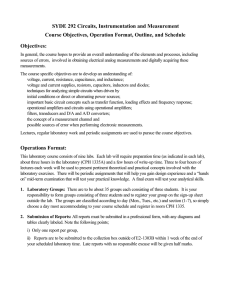AP20007
advertisement

Subject Description Form Subject Code AP20007 Subject Title Fundamentals of Scientific Instrumentation Credit Value 3 Level 2 Pre-requisite/ Co-requisite/ Exclusion Nil Objectives (1) Provide students with an understanding of the theory, the characteristics, the operation and the application of scientific instruments in measurement. (2) Introduce the techniques in digital and analogue signal processing. Intended Learning Outcomes Upon completion of the subject, students will be able to: (a) describe and explain the theory, characteristics, operation and applications of the basic instruments in electrical measurements; (b) solve problems in analogue instrumentation using Golden rules, Ohm’s law and Kirchhoff’s rules for circuits involving operational amplifiers, capacitors and resistors; (c) interpret experimental data and specify sources of errors; and (d) apply knowledge in instrumentation to the development and servicing of instruments, appliances and devices. Analog circuit: I-V characteristics of general nonlinear components (diode and Subject Synopsis/ Indicative Syllabus transistor); rectifier circuits; clipping and clamping circuits; operational amplifiers – frequency response characteristics, linear and nonlinear circuits, active filters and oscillators, signal generators. Digital circuit: Boolean algebra; basic logic gates; flip-flops; Karnaugh maps; combinational and sequential logic circuits; concepts of A/D and D/A conversions. Measurement techniques and electronic instruments: Measurement and error; displacement and thermal transducers and their applications. Teaching/Learning Lecture: Background knowledge behind all experiments will be systematically introduced in lectures. Class work and assignments related to the content of lectures will Methodology be used to enhance students learning. Lab session: Experiments are essential for students to relate the concepts to practical applications and they are exposed to hands-on experience and proper use of equipment and also analytical skills on interpreting experimental results. Assessment Methods in Alignment with Intended Learning Outcomes Specific assessment methods/tasks % weighting Intended subject learning outcomes to be assessed Please tick as appropriate) a b c d (1) Continuous assessment 35 ✓ ✓ ✓ ✓ (2) Practical test 15 ✓ ✓ ✓ ✓ (3) Examination 50 ✓ ✓ ✓ ✓ Total 100 Assignments will strengthen the students’ basic knowledge and the analytical skills to solve the problems related to this subject. Practical Tests is useful to assess students’ experimental skills and knowledge learned from the lectures and lab works. Examination will review their understanding of the course and assess their ability to solve problems. Student Study Effort Expected Class contact: Lecture 28 h Tutorial 6h Laboratory 12h Other student study effort: Self-study Total student study effort Reading List and References 74 h 120 h A.H. Robbins and W.C. Miller, “Circuit Analysis: Theory and Practice”, 2nd Edition, Thomson Learning, 2000. R.F. Coughlin and F.F. Driscoll, “Operational Amplifiers & Linear Integrated Circuits”, 6th Edition, Prentice Hall, 2001.





